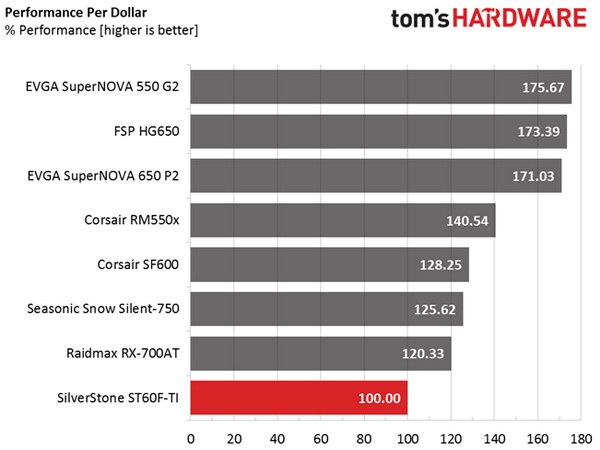SilverStone Strider Titanium ST60F-TI PSU Review
SilverStone released its first Titanium PSU series, which is made by Enhance Electronics. The smallest Strider Titanium unit will be under our scope today. Besides high efficiency it also offers compact dimensions and a fully modular cable design.
Why you can trust Tom's Hardware
Performance, Performance Per Dollar, Noise And Efficiency Ratings
Performance Rating
The following graph shows the total performance rating of the PSU, comparing it to other units we have tested in the past. To be more specific, the tested unit is shown as 100 percent, and every other unit's performance is shown relative to it.
Mostly because of increased ripple on the +12V rail, the ST60F-TI doesn't do so well in this chart, even compared to lower-efficiency units.
Performance Per Dollar
The following chart may be the most interesting to many of you because it depicts the unit's performance-per-dollar score. We looked up the current price of each PSU on popular online shops and used those prices and all relative performance numbers to calculate the index. If the specific unit wasn't available in the United States, we searched for it in popular European Union shops, converting the listed price to USD (without VAT). Note that all of the numbers in the following graph are normalized by the rated power of each PSU.
Given an exorbitant price, the ST60F-TI's last-place finish in our performance/dollar chart doesn't come as a surprise.
Noise Rating
The graph below depicts the cooling fan's average noise over the PSU's operating range, with an ambient temperature between 28 °C and 30 °C (82 °F to 86 °F).
Despite the lack of a semi-passive mode, SilverStone's ST60F-TI achieves pretty low average noise output.
Efficiency Rating
The following graph shows the average efficiency of the PSU throughout its operating range, with an ambient temperature between 28 °C and 30 °C.
Get Tom's Hardware's best news and in-depth reviews, straight to your inbox.
Efficiency is clearly this power supply's advantage. But are you willing to pay a premium price for it?
Current page: Performance, Performance Per Dollar, Noise And Efficiency Ratings
Prev Page Ripple Measurements Next Page Pros, Cons And Final Verdict
Aris Mpitziopoulos is a contributing editor at Tom's Hardware, covering PSUs.
-
JamesSneed So essentially this is a overpriced PSU with to much ripple. This left me wondering why the EVGA SuperNova 850 T2 was not in the charts. You mentioned the SuperNova towards the end and it just seems like the proper competitor since its another TI rated PSU.Reply -
Jack_565 Nice to see a review on at least one of the Strider Titanium units.Reply
I recently purchased a 800w Version(these are the only Titanium PSUs in the Australian Market under 1000w) and its been everything i've wanted, running at almost 50% load it gives me its peak efficiency which is exactly why i paid the premium to get a Titanium PSU.
I can see the 600w version being a more commonly purchased unit with the way power consumption has dropped, Skylake Rigs only use around 300w(give or take variables) which would be the Striders peak efficiency. -
turkey3_scratch Jonnyguru also did a review on the same unit here, so the "high" ripple is consistent among these units. Probably due to a lack of filter capacitors, either to increase efficiency or conserve space. I'd like to see how the efficiency would be improved if they used a relay.Reply
What I don't understand is the small transformer. Aris, you mentioned that this unit, to have higher efficiency, switches to not-as-high of a frequency (which also affects transient response negatively). Since transformer size is inversely proportional to the AC frequency, wouldn't the transformer have to be larger? Is there any downside to a smaller transformer?
Yet again, more PWR_OK cheaters. It seems like at least one in two PSUs are like this. I agree that no power switch on this unit seems very silly to me. -
Aris_Mp The switching frequency probably isn't as high in order to achieve the higher possible efficiency, but this doesn't necessary means that it isn't high enough to allow for a small main transformer. In addition the design of the transformer plays a key role also in this.Reply



